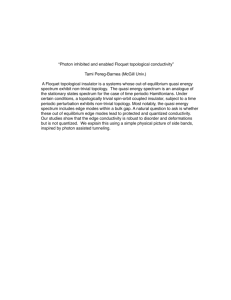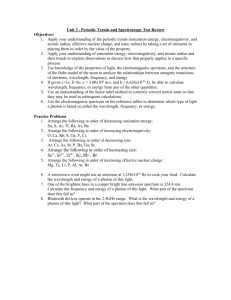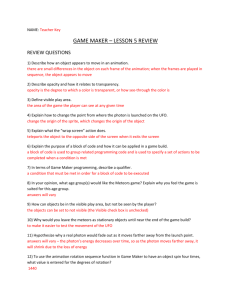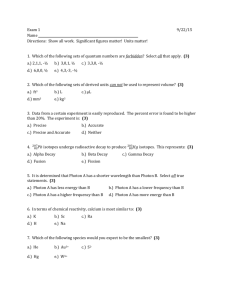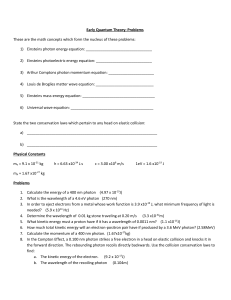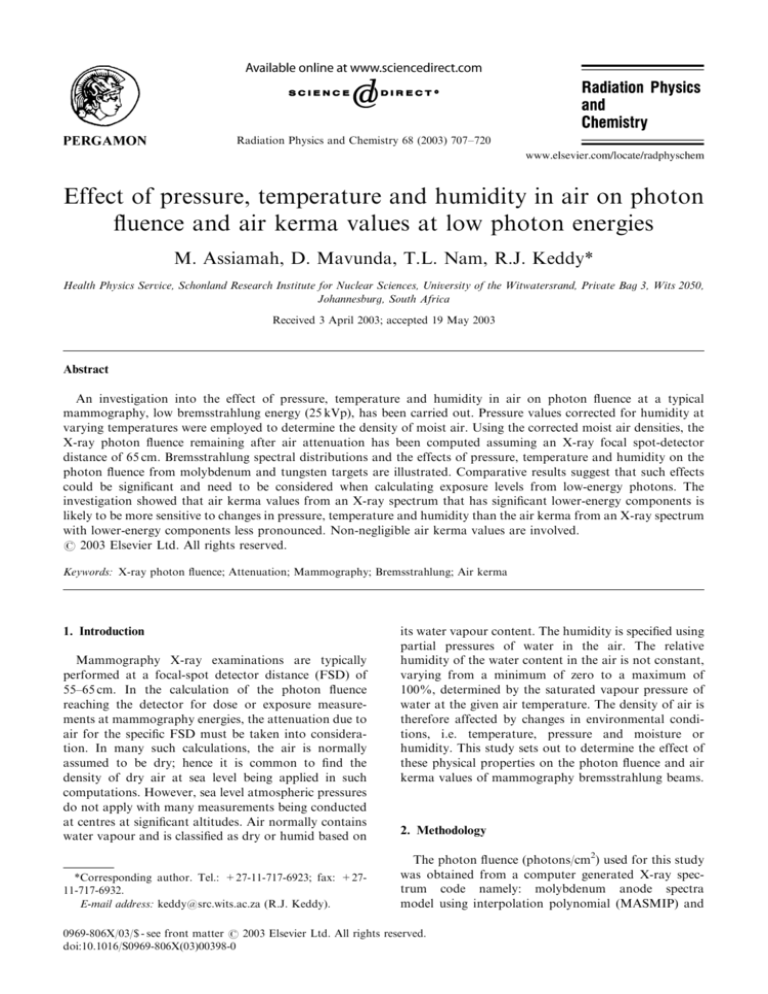
ARTICLE IN PRESS
Radiation Physics and Chemistry 68 (2003) 707–720
Effect of pressure, temperature and humidity in air on photon
fluence and air kerma values at low photon energies
M. Assiamah, D. Mavunda, T.L. Nam, R.J. Keddy*
Health Physics Service, Schonland Research Institute for Nuclear Sciences, University of the Witwatersrand, Private Bag 3, Wits 2050,
Johannesburg, South Africa
Received 3 April 2003; accepted 19 May 2003
Abstract
An investigation into the effect of pressure, temperature and humidity in air on photon fluence at a typical
mammography, low bremsstrahlung energy (25 kVp), has been carried out. Pressure values corrected for humidity at
varying temperatures were employed to determine the density of moist air. Using the corrected moist air densities, the
X-ray photon fluence remaining after air attenuation has been computed assuming an X-ray focal spot-detector
distance of 65 cm. Bremsstrahlung spectral distributions and the effects of pressure, temperature and humidity on the
photon fluence from molybdenum and tungsten targets are illustrated. Comparative results suggest that such effects
could be significant and need to be considered when calculating exposure levels from low-energy photons. The
investigation showed that air kerma values from an X-ray spectrum that has significant lower-energy components is
likely to be more sensitive to changes in pressure, temperature and humidity than the air kerma from an X-ray spectrum
with lower-energy components less pronounced. Non-negligible air kerma values are involved.
r 2003 Elsevier Ltd. All rights reserved.
Keywords: X-ray photon fluence; Attenuation; Mammography; Bremsstrahlung; Air kerma
1. Introduction
Mammography X-ray examinations are typically
performed at a focal-spot detector distance (FSD) of
55–65 cm. In the calculation of the photon fluence
reaching the detector for dose or exposure measurements at mammography energies, the attenuation due to
air for the specific FSD must be taken into consideration. In many such calculations, the air is normally
assumed to be dry; hence it is common to find the
density of dry air at sea level being applied in such
computations. However, sea level atmospheric pressures
do not apply with many measurements being conducted
at centres at significant altitudes. Air normally contains
water vapour and is classified as dry or humid based on
*Corresponding author. Tel.: +27-11-717-6923; fax: +2711-717-6932.
E-mail address: keddy@src.wits.ac.za (R.J. Keddy).
its water vapour content. The humidity is specified using
partial pressures of water in the air. The relative
humidity of the water content in the air is not constant,
varying from a minimum of zero to a maximum of
100%, determined by the saturated vapour pressure of
water at the given air temperature. The density of air is
therefore affected by changes in environmental conditions, i.e. temperature, pressure and moisture or
humidity. This study sets out to determine the effect of
these physical properties on the photon fluence and air
kerma values of mammography bremsstrahlung beams.
2. Methodology
The photon fluence (photons/cm2) used for this study
was obtained from a computer generated X-ray spectrum code namely: molybdenum anode spectra
model using interpolation polynomial (MASMIP) and
0969-806X/03/$ - see front matter r 2003 Elsevier Ltd. All rights reserved.
doi:10.1016/S0969-806X(03)00398-0
ARTICLE IN PRESS
708
M. Assiamah et al. / Radiation Physics and Chemistry 68 (2003) 707–720
tungsten anode spectra model using interpolation
polynomial (TASMIP) developed by Boone et al.
(1997). The X-ray spectrum for a 25 kVp tube potential
was generated from both the MASMIP and TASMIP
models. A nominal filtration of 0.03 mm molybdenum
was applied to the molybdenum target spectrum, whilst
a 0.05 mm rhodium filtration was applied to the tungsten
target spectrum. The spectral shaping (filters) materials
applied are routinely used on clinical mammography
systems. A focal spot-detector distance of 65 cm (an
FSD commonly used at clinical mammography settings)
was assumed for the calculation. For computational
purposes the bremsstrahlung spectrum was divided into
0.5 keV energy bins. The photon fluence remaining in
each bin after air attenuation was calculated by
applying, to each bin, the energy-dependent Lambert–
Beer’s law equation
f ¼ f0 expðmeÞ;
ð1Þ
where f is the photon fluence (photon/cm2) in each bin
after attenuation by air of thickness e (g/cm2) with mass
attenuation coefficients m (cm2/g) and f0 is the initial
photon fluence before attenuation (Archer and Wagner,
1982; Attix, 1986; Wolbarst, 1993). The thickness e is
given by the product of the density r in g/cm3 and the
focal spot-detector distance x in cm. The density of air
used in Eq. (1) has been corrected for temperature,
pressure and humidity. The corrected air densities used
for this investigation are those given in the CRC
Handbook of Chemistry and Physics (1983–1984) for a
temperature range of 5–35 C and corrected pressure
range of 600–780 mmHg. The densities for moist air at
temperatures 40 C, 45 C and 50 C, not given in the
reference for the specified corrected pressures, were
calculated using Eq. (2) and Table II of section F of
Weast et al. (1983–1984).
The density rT;P;H of moist air at absolute temperature T, barometric pressure P in mmHg, is given by
273:13 P 0:3783e
;
ð2Þ
rT;P;H ¼ 1:2929
T
760
where 1.2929 is the density of dry air in g/l at standard
temperature and pressure (s.t.p.) i.e. 0 C/273.13 K and
760 mmHg/101.3 kPa, respectively. The parameter ‘‘e’’
appearing in Eq. (2) is the vapour pressure of the
moisture in the air in millimetres. Employing the dewpoint method and the vapour pressure of water at
different dew points, the humidity H of the air has been
accounted for (Marion and Hornyak, 1982). The
corrected pressure values at various temperatures were
then employed to determine the density of moist air for
the calculated relative humidity. Relative humidities of
0–100% at intervals of 10% were used in the calculations.
Using the photon fluence fiðcorrÞ ; that which remains
after 65 cm air attenuation, exposures Xi ðEÞT;P;H in
roentgen (R) at absolute temperature T, barometric
pressure P and humidity H was calculated employing
Xi ðEÞT;P;H ¼
1:83 1011 fiðcorrÞ Ei ðmen rÞairi
:
rT;P;H
ð3Þ
The subscript i refers to the ith photon energy interval Ei
(keV), men, is the mass energy-absorption coefficient
(cm2/g) of air at s.t.p., r and rT;P;H are the densities of
air at s.t.p. and at absolute temperature T, barometric
pressure P in mmHg, and relative humidity H,
respectively (Cember, 1996). From the exposure Xi(E)
values, the air kerma Ki (E) values in cGy were
calculated using the exposure and air kerma relationship
given by Wolbarst (Wolbarst, 1993).
Ki ðEÞ ¼ 0:873Xi ðEÞ:
ð4Þ
The mass attenuation and mass energy-absorption
coefficients data used for this study are those compiled
by Hubbell and Seltzer (1996) and reworked into an
extremely user-friendly windows program, WinXCom,
(Gerward et al., 2001). To obtain data covering the
energy of interest, a fitting algorithm was developed to
obtain mass energy-absorption coefficient values with
negligible deviation from the original published data
(Assiamah et al., 2003). Both the mass attenuation and
mass energy coefficients data were corrected to s.t.p.
In analysing the results, the photon fluence data at
temperature 0 C, 760 mmHg corrected pressure and 0%
relative humidity was chosen as a reference data point.
The results of the study are presented in tabular and
graphical forms.
3. Results and discussion
The effects of pressure on the photon fluence are
illustrated in Figs. 1 and 2 for the molybdenum target
spectrum and in Figs. 3 and 4 for the tungsten target.
The temperature effects on the photon fluence are
presented in Figs. 5 and 6 for the molybdenum target
and in Figs. 7 and 8 for the tungsten target. The effects
of humidity on the photon fluence are illustrated in Figs.
9 and 10 for the molybdenum target and in Figs. 11 and
12 for the tungsten target.
A comparison of a typical photon fluence (photons/
cm2) spectrum from molybdenum and tungsten targets
at tube voltage of 25 kVp, 760 mmHg, 0 C and 0%
relative humidity (reference spectrum) with a spectrum
at the same tube voltage but corrected for air density at
a pressure of 600 mmHg, temperature 35 C and 50%
relative humidity are shown in Figs. 13, 14 and 15,
respectively. Table 1 presents a comparison of the
contributions of three arbitrary energy segments to the
overall photon fluence from the reference and corrected
molybdenum spectra. The comparison of the photon
ARTICLE IN PRESS
M. Assiamah et al. / Radiation Physics and Chemistry 68 (2003) 707–720
709
Fig. 1. Deviation of the photon fluence due to pressure variation from the photon fluence calculated at 0 C, 760 mmHg and 0%
relative humidity for a molybdenum target at 25 kVp.
Fig. 2. Overall deviation (%) due to pressure on the integrated photon fluence from the photon fluence calculated at 0 C, 760 mmHg
and 0% relative humidity for a molybdenum target spectrum at 25 kVp.
ARTICLE IN PRESS
710
M. Assiamah et al. / Radiation Physics and Chemistry 68 (2003) 707–720
Fig. 3. Deviation of the photon fluence due to pressure variation from the photon fluence calculated at 0 C, 760 mmHg and 0%
relative humidity for a tungsten target at 25 kVp.
Fig. 4. Overall deviation (%) due to pressure on the integrated photon fluence from the photon fluence calculated at 0 C, 760 mmHg
and 0% relative humidity for a tungsten target spectrum at 25 kVp.
ARTICLE IN PRESS
M. Assiamah et al. / Radiation Physics and Chemistry 68 (2003) 707–720
711
Fig. 5. Deviation of the photon fluence due to temperature variation from the photon fluence calculated at 0 C, 760 mmHg and 0%
relative humidity for a molybdenum target at 25 kVp.
Fig. 6. Overall deviation (%) due to temperature on the integrated photon fluence from the photon fluence calculated at 0 C,
760 mmHg at 0% relative humidity for a molybdenum target at 25 kVp.
ARTICLE IN PRESS
712
M. Assiamah et al. / Radiation Physics and Chemistry 68 (2003) 707–720
Fig. 7. Deviation of the photon fluence due to temperature variation from the photon fluence calculated at 0 C, 760 mmHg and 0%
relative humidity for a tungsten target spectrum at 25 kVp.
Fig 8. Overall deviation (%) due to temperature on the integrated photon fluence from the photon fluence calculated at 0 C,
760 mmHg and 0% relative humidity for a tungsten target spectrum at 25 kVp.
ARTICLE IN PRESS
M. Assiamah et al. / Radiation Physics and Chemistry 68 (2003) 707–720
713
Fig. 9. Deviation of photon fluence due to a humidity variation from the photon fluence calculated at 0 C and 760 mmHg for a
molybdenum target at 25 kVp.
Fig. 10. Overall deviation (%) due to humidity on the integrated photon fluence from the photon fluence calculated at 0 C and
760 mmHg for a molybdenum target at 25 kVp.
ARTICLE IN PRESS
714
M. Assiamah et al. / Radiation Physics and Chemistry 68 (2003) 707–720
Fig. 11. Deviation of photon fluence due to a humidity variation from the photon fluence calculated at 0 C and 760 mmHg for a
tungsten target at 25 kVp.
Fig. 12. Overall deviation (%) due to humidity on the integrated photon fluence from the photon fluence calculated at 0 C, 760 mmHg
at 0% relative humidity for a tungsten target at 25 kVp.
ARTICLE IN PRESS
M. Assiamah et al. / Radiation Physics and Chemistry 68 (2003) 707–720
715
Fig. 13. A comparison of the photon fluence spectrum from a molybdenum target at 25 kVp. (A) Spectrum at 760 mmHg, 0 C and 0%
relative humidity. (B) Spectrum corrected for temperature (35 C), pressure (600 mmHg) and relative humidity (50%).
Fig. 14. A comparison of the air kerma spectrum from a molybdenum target at 25 kVp. (A) Spectrum at 760 mmHg, 0 C and 0%
relative humidity. (B) Spectrum corrected for temperature (35 C), pressure (600 mmHg) and relative humidity (50%).
ARTICLE IN PRESS
716
M. Assiamah et al. / Radiation Physics and Chemistry 68 (2003) 707–720
Fig. 15. A comparison of the photon fluence spectrum from a tungsten target at 25 kVp. (A) Spectrum at 760 mmHg, 0 C and 0%
relative humidity. (B) Spectrum corrected for temperature (35 C), pressure (600 mmHg) and 50% relative humidity.
Table 1
Comparison of contributions of three arbitrary energy segments to the overall photon fluence (photons/cm2) from a molybdenum
spectrum at 25 kVp, 0 C, 760 mmHg and 0% relative humidity with the molybdenum target spectrum at the same tube voltage and
corrected for temperature, pressure and humidity
Contribution to photon
fluence by energy range
4–8 keV
Contribution to photon
fluence by energy range
8–15 keV
2.14E+09
Contribution to photon
fluence by energy range
15–25 keV
Photon fluence at
760 mmHg,
0 C, 0% RH~
Total contribution
4.73E+06
Percent contribution (%)
0.07
Photon fluence at
600 mmHg
35 C, 50% RH
Total contribution
6.12E+06
Percent contribution (%)
0.09
34.64
70.08
% difference in photon
fluence due to P, T, H Y
correction
29.47
6.58
2.73
33.80
2.29E+09
4.50E+09
70.93
4.62E+09
The overall percentage difference in the photon fluence due to the combined effects of temperature, pressure and humidity is also
shown. Overall difference in photon fluence due to P, T and H correction=3.98%.
~
RH is relative humidity.
Y
P, T and H are the pressure, temperature and humidity, respectively.
fluence from the reference and corrected tungsten
spectra are similarly shown in Table 3.
A comparison of the contributions of three arbitrary
energy segments to the overall air kerma values for both
the reference and corrected molybdenum and tungsten
spectra are presented in Tables 2 and 4. For purposes of
illustrating the weights of contributions from various
regions of the spectrum, three arbitrary energy segments
ARTICLE IN PRESS
M. Assiamah et al. / Radiation Physics and Chemistry 68 (2003) 707–720
717
Table 2
Comparison of contributions of three arbitrary energy segments to the overall air kerma in cGy from a molybdenum spectrum at
25 kVp, 0 C, 760 mmHg and 0% relative humidity with the molybdenum target spectrum at the same tube voltage and corrected for
temperature, pressure and humidity
Contribution to air
kerma by energy
range 4–8 keV
Contribution to air
kerma by energy
range 8–15 keV
Contribution to air
kerma by energy
range 15–25 keV
Air kerma (cGy) at
760 mmHg,
0 C, 0% RH
Total contribution
Percent contribution (%)
0.006
0.31
0.912
50.43
0.985
54.46
Air kerma (cGy) at
600 mmHg
35 C, 40% RH
Total contribution
Percent contribution (%)
0.011
0.38
1.416
51.55
1.463
53.25
55.23
48.48
% difference in air
kerma due to P, T, H
correction
87.52
The overall percentage due to the combined effects of temperature, pressure and humidity is also shown. Overall difference in air kerma
due to P, T and H correction=51.85%.
Table 3
Comparison of contributions of three arbitrary energy segments to the overall photon fluence from tungsten spectrum at 25 kVp, 0 C,
760 mmHg and 0% relative humidity with the tungsten target spectrum at the same tube voltage and corrected for temperature,
pressure and humidity
Contribution to photon
fluence by energy range
6–8 keV
Contribution to photon
fluence by energy range
8–15 keV
Contribution to photon
fluence by energy range
15–25 keV
Photon fluence at
760 mmHg,
0 C, 0% RH
Total contribution
Percent contribution (%)
1.15E+04
0.0003
4.75E+08
13.97
3.04E+09
89.32
Photon fluence at
600 mmHg
35 C, 40% RH
Total contribution
Percent contribution (%)
1.47E+04
0.0004
5.01E+08
14.35
3.11E+09
88.99
% difference in
photon fluence due to
P, T, H correction
27.48
5.46
2.29
The overall percentage due to the combined effects of temperature, pressure and humidity is also shown. Overall difference in estimated
photon fluence due to P, T and H correction=2.68%.
were selected: 4–8, 8–15 and 15–25 keV for the molybdenum spectrum and 6–8, 8–15 and 15–25 keV for the
tungsten spectrum. The overall difference in the
estimated air kerma values of the entire molybdenum
and tungsten spectra due to the combined effects of
temperature, pressure and humidity correction is also
shown in Tables 2 and 4.
3.1. Pressure
As expected, the effect of pressure was more pronounced at the lower energies than at higher energies (Fig. 1).
For the molybdenum spectrum, a deviation range from
less than 10–260% was observed, between the energies 4
and 10 keV, for a pressure range of 600–700 mmHg. For
the same energy range, the deviation was 2–50% for
pressure values 720–780 mmHg. Above 10 keV, the
deviations due to pressure effects ranged from less than
1% to 10% for the entire pressure range of 600–
780 mmHg. The overall effect of pressure on the
integrated photon fluence is minimal with a maximum
of 3% at 600 mmHg pressure and a minimum of 0.33%
at 780 mmHg (Fig. 2). The low overall deviation of
pressure on the photon fluence in spite of the high
deviations at the lower energies is due to the fact that
after filtration of the spectrum, the lower-energy
ARTICLE IN PRESS
718
M. Assiamah et al. / Radiation Physics and Chemistry 68 (2003) 707–720
Table 4
Comparison of contributions of three arbitrary energy segments to the overall air kerma from a tungsten spectrum at 25 kVp, 0 C,
760 mmHg and 0% relative humidity with the tungsten target spectrum at the same tube voltage and corrected for temperature,
pressure and humidity
Contribution to air
kerma (cGy) by energy
range 6–8 keV
Contribution to air
kerma (cGy) by energy
range 8–15 keV
Contribution to air
kerma (cGy) by energy
range 15–25 keV
Air kerma (cGy) at
760 mmHg,
0 C, 0% RH
Total contribution
Percent contribution (%)
1.32E05
0.0018
0.18
24.96
0.57
79.74
Air kerma (cGy) at
600 mmHg
35 C, 40% RH
Total contribution
Percent contribution (%)
2.42E05
0.0023
0.27
25.60
0.84
79.13
52.94
47.96
% difference in air
kerma due to P, T, H
correction
84.13
The overall percentage due to the combined effects of temperature, pressure and humidity is also shown. Overall difference in estimated
air kerma (cGy) due to P, T and H correction=49.2%.
component is removed hence its contribution towards
the entire spectrum is reduced. The deviation pattern is
similar for both molybdenum and tungsten targets (Figs.
3 and 4). The figures involved are however different. The
effects on the tungsten target spectrum being lower than
that from the molybdenum. The difference in the
pressure effect on the molybdenum and tungsten targets
is as a result of the molybdenum X-ray spectrum having
many more lower-energy components when compared
to the X-ray spectrum from tungsten.
3.3. Humidity
The humidity effects on the photon fluence for the
molybdenum and tungsten targets were very low
compared to the pressure and temperature effects. The
deviations due to humidity effects on the entire energy
spectrum of both the molybdenum and tungsten targets
were less than 5% (Figs. 9 and 11) for the full relative
humidity range, 0–100%, at all temperatures considered.
3.4. Pressure, temperature and humidity
3.2. Temperature
The temperature effect on the photon fluence increases with increasing temperature. Below 10 keV, and
for temperature range of 5–25 C, a deviation of 1–70%
was calculated for the molybdenum target (Fig. 5). For
the same energies, the deviation was about 5–120% at
temperatures 30–40 C. At temperatures above 40 C,
deviations of 5% to more than 150% were observed for
the same energy range. At energies greater than 10 keV,
the deviations were much lower and ranged from less
than 1–10% for the entire temperature range, 5–50 C.
The overall temperature effect on the photon fluence
from a molybdenum target yielded a deviation of 0.25–
2% (Fig. 6). The patterns of the temperature effect on
both the molybdenum and tungsten targets were similar
(Figs. 7 and 8). The temperature effect was however
lower for the tungsten target than for the molybdenum
target. This may be attributed to the proportionally
larger contribution from the low-energy components
that are present in the molybdenum spectrum when
compared to tungsten X-ray spectrum.
The photon fluence comparison (Table 1) showed that
the effect of the pressure, temperature and humidity
correction on the three arbitrary energy ranges chosen
for the molybdenum target varied with the effect being
highest (29.5%) in the lower energy range; 6.6% and
2.7% for the energy ranges 8–15 and 15–25 keV,
respectively. The overall difference in photon fluence
of the molybdenum spectrum due to the correction for
P, T and H was 4%. The overall difference was low in
view of the fact that the contribution to the lower-energy
segment of the spectrum from molybdenum is reduced
due to filtration. The photon fluence comparison for the
tungsten spectrum (Table 3) followed a similar pattern
to the molybdenum spectrum with the overall difference
even smaller.
The results from the air kerma calculations of the
molybdenum spectra (Table 2) indicate that at the
energy range 4–8 keV, the combined effects of pressure,
temperature and humidity is significant. The contribution of air kerma for this energy range to the air kerma
of the entire spectrum is however negligible. The
contribution to the calculated air kerma in the energy
range 8–15 keV was 52% for the molybdenum spectrum
ARTICLE IN PRESS
M. Assiamah et al. / Radiation Physics and Chemistry 68 (2003) 707–720
719
difference in the estimated air kerma of the entire
spectrum due to the combined effects of pressure,
temperature and humidity was 52% and 49%, respectively, for the molybdenum and tungsten spectra at 0 C,
760 mmHg and 0% relative humidity shown in Figs. 14
and 16 (Tables 2 and 4), respectively. For the molybdenum spectrum, the air kerma difference contrasts
significantly with the 45% overall difference obtained
routinely by correcting for pressure and temperature
only (Table 5).
corrected for air density and 50% for the reference
molybdenum spectrum. For the same energy range, the
contribution to the calculated air kerma was 26% and
25% respectively, for the corrected and reference
tungsten spectra (Table 4). The overall percentage
difference in the estimated air kerma value due to the
pressure, temperature and humidity correction at this
energy range was 55% and 53%, respectively, for the
molybdenum and tungsten spectra (Tables 2 and 4). For
the energy range 15–25 keV, the contribution to the
estimated air kerma was 53% and 54%, respectively, for
the corrected and reference molybdenum spectra; 79%
and 80%, respectively, for the corrected and reference
tungsten spectra. The overall difference in the estimated
air kerma at this energy range, due to pressure,
temperature and humidity correction was 48% for both
the molybdenum and tungsten spectra. The overall
4. Conclusion
The investigation has shown that the effect of pressure
on photon fluence of an X-ray spectrum from both
molybdenum and tungsten targets are significant at
Fig. 16. A comparison of the air kerma spectrum from a tungsten target at 25 kVp. (A) Spectrum at 760 mmHg, 0 C and 0% relative
humidity. (B) Spectrum corrected for temperature (35 C), pressure (600 mmHg) and 50% relative humidity.
Table 5
Comparison of change in the air kerma values obtained using normal temperature and pressure correction with values obtained from
the correction procedure outlined in this study
X-ray target material
Predicted air kerma change (%)
Expected air kerma change
after normal P, T correction (%)
Predicted—Expected (%)
Mo
W
52
49
45
45
7
4
ARTICLE IN PRESS
720
M. Assiamah et al. / Radiation Physics and Chemistry 68 (2003) 707–720
photon energies less than 10 keV. Lower-pressure values
showed higher deviations on the photon fluence at this
energy range than higher-pressure values. Notwithstanding this observation, the contribution of the lowerenergy segment to the entire spectrum is reduced after
filtration; hence, the overall deviation due to pressure of
the integrated photon fluence was found to be small. It
has also been established from this study that the
temperature effect on photon fluence for both target
materials are significant at the lower-energy segment of
the X-ray spectrum. The temperature effect on the
tungsten spectrum is however less than for the molybdenum target. The moisture content of the air has been
found not to have any appreciable effect on photon
fluence at any energy segment of the spectrum unlike
temperature and pressure. The study has established
that for high-altitude areas where air pressures are low,
there could be a 4% difference in photon fluence when
temperatures are high. It has also been established that
for the same atmospheric conditions (low pressures and
high temperatures) there could be a 50% overall
difference in estimated air kerma values in mammography or low bremsstrahlung energy beam measurements
unless the air density is corrected for pressure and
temperature.
The results presented suggest that unless air density is
corrected for atmospheric conditions at the time of
measurements, the overall difference in the estimated air
kerma could be large. In the case of an X-ray spectrum
with a high proportion of low-energy contributions,
unless the effect of temperature, pressure and humidity
on the photon flux is considered over the entire energy
range, errors in kerma values significantly larger than
values obtained after normal routine temperature and
pressure corrections could result. This can partly be
attributed, to changes in the photon fluence spectrum
resulting from changes in atmospheric conditions and
partly due to the influence of the energy and the linear
energy-absorption product term ðEi Þðmen rÞ; shown in
Eq. (3).
Acknowledgements
The authors wish to express their gratitude to Dr. J.
M. Boone, Dr. T. R. Fewell and Dr. R. J. Jennings who
made available their molybdenum and tungsten anode
spectral models used for this study.
References
Archer, B.R., Wagner, L.K., 1982. Med. Phys. 9, 844–847.
Assiamah, M., Mavunda, D., Nam, T.L., Keddy, R.J., 2003.
Radiat. Phys. Chem. 67, 1–6.
Attix, F.H., 1986. Introduction of Radiological Physics and
Radiation Dosimetry. Wiley-Interscience, New York, pp.
39–46.
Boone, J.M., Fewell, T.R., Jennings, R.J., 1997. Med. Phys. 24,
1863–1874.
Cember, H., 1996. Introduction to Health Physics (3rd
Edition), McGraw-Hill, New York, pp. 169–179.
Gerward, L., Guilbert, N., Jensen, K.B., Levring, H., 2001.
Rad. Phys. Chem. 60, 23–24.
Hubbell, J.H., Seltzer, S.M., 1996. Tables of X-ray Mass
Attenuation Coefficients and Mass Energy-Absorption
Coefficients from 1 keV to 20 MeV for Elements Z=1 to
92 and 48 Additional Substances of Dosimetric Interest.
National Institute of Standards and Technology, US
Department of Commerce, Gaithersburg, MD 20899.
Marion, J.B., Hornyak, W.F., 1982. Physics for Science and
Engineering, Part 1. Saunders College Publishing, New
York, pp. 655–658.
Weast, R.C., Astle, M.J., Beyer, W.H. (Eds.), 1983–1984. CRC
Handbook of Chemistry and Physics, CRC Press, Boca
Raton, FL, pp. F-9, F-10.
Wolbarst, A.B., 1993. Physics of Radiology, International
Edition. Appleton and Lange, Connecticut, USA, pp. 96,
122–131.




